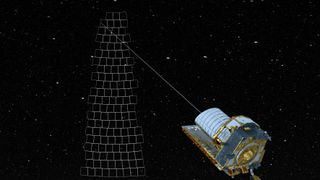Home
News
Science & Astronomy

Europe’s new space telescope Euclid will maps dark matter and search for evidence of dark energy in the universe.
(Image credit: ESA)
There is a problem with our understanding of the universe: It doesn’t make sense if we account only for the matter and energy that we can see, measure or detect.
Albert Einstein’s famous general theory of relativity, which describes the physical ‘rules’ of the universe in a series of equations only adds up on cosmic scales if there is five times as much matter dispersed throughout the cosmos than what we can see and detect.
This invisible matter, or dark matter, together with another invisible entity, dark energy, form the biggest mystery in cosmology, the study of the origins of the universe. While dark matter pulls stuff together with the force of gravity, the elusive dark energy seems to be doing the exact opposite, pushing things apart and causing the acceleration of the expansion of the universe that was first discovered in 1998. Together, dark energy and dark matter account for a mind-boggling 95% of the “stuff” in the universe, and we know close to nothing about this “stuff.”
But how do you study something that can’t be seen, touched or heard? Europe’s new Euclid telescope may have just the solution.
Related: Is dark matter fuzzy? Ultracold state of matter could shed light
Solving cosmology’s greatest mystery
“Dark matter is something that gravity works on in the same way as normal matter, but it doesn’t interact with any light or any anything so we only know it’s there by the effect it has on the movements of galaxies and stars,” Isobel Hook, a professor of astrophysics at Lancaster University in the U.K. and a Euclid scientist, told Space.com. “Whereas dark energy is something we found out about more recently when we discovered that the expansion of the universe seems to be getting faster with time. That doesn’t make any sense if you think there’s just gravity there. It should be slowing down.”
Hook was part of the team that discovered this mysterious acceleration, for which the lead investigator of that research, American astronomer Saul Perlmutter, received the 2011 Nobel Prize for Physics. Since then, Hook, just like many other astronomers, has been hoping to find out what that invisible ‘something’ pushing the universe apart actually is. The new European Euclid telescope, launching on Saturday, July 1, might bring that answer a little closer into view. The spacecraft, fitted with a 3-foot-11 inch (1.2 meters) telescope, will also help map the distribution of dark matter across spacetime in three dimensions for the first time ever.
But how exactly is Euclid going to “reveal” the existence of the invisible universe when it cannot see and measure it? The telescope, fitted with sensors capable of detecting visible and infrared light, will join the famed James Webb Space Telescope at Lagrange Point 2. In this region some 900,000 miles (1.5 million kilometers) away from Earth, the gravitational forces of the planet and the sun are equal, keeping the spacecraft in a stable location relative to Earth. Here, shielded from the glare of the star at the center of our solar system, Euclid will look into the depths of the cosmos, 10 billion years back in time, to map the distribution of galaxies across one third of the sky outside our Milky Way galaxy. It will take over six years for the $660 million telescope to complete its survey.
Gravitational lensing
Euclid’s images, which will look quite like the famous Hubble Space Telescope’s Deep Field images, will also allow astronomers to study how the gravity of invisible dark matter alters the shapes of the galaxies as they appear in those images.
“If you’ve got a very large clump of matter, any sort of matter, not necessarily dark matter, it will bend the light rays,” Hook explained. “Which means that anything behind that type of matter will look distorted.”
These distortions, also known as the gravitational lensing effect, are minuscule — so minuscule in fact, that they can’t be accurately measured by ground-based telescopes due to the blurring caused by Earth’s atmosphere.
“The effect is very tiny, less than 1%,” Giuseppe Racca, Euclid project manager at the European Space Agency (ESA), told Space.com. “To detect this tiny effect is very difficult. We need to be very, very precise with our image quality and measure many, many galaxies to be able to deduce anything.”
By using some rather complicated math, astronomers will be able to use these gravitational lensing measurements to calculate the amount of dark matter between Euclid and each distorted galaxy, allowing them to create the first ever 3D map of the dark matter’s distribution in the universe.
Racca said that although dark matter has never been directly observed, scientists are quite certain of its existence.
“There is evidence of dark matter in so many ways that it is quite unlikely that Euclid could find evidence through measuring the gravitational lensing that it does not exist,” said Racca. “I think that dark matter must exist because there is simply not enough normal matter to grow [galaxy] structures, to have them assemble the way they are.”
Challenging Einstein’s theory of relativity
The existence of dark energy, on the other hand, is less certain and it’s in this area where Euclid scientists expect the biggest surprises. At stake is the ultimate validation of Albert Einstein’s famous and widely accepted theory of relativity, which claims to capture what is supposed to be the universal rules of the behavior of all matter and energy in the cosmos.
“It could be simply that general relativity doesn’t really work at cosmic scale, and therefore dark energy is not needed,” said Racca. “We need dark energy now if we assume that general relativity works. Dark energy is not needed to grow the cosmic structures, to grow stars and galaxies.”
Many experiments and observations made at smaller distances have confirmed the theory of general relativity over the years. If Euclid’s measurements were to take this theory into question, it would be “an absolute discovery,” according to Racca.
The imprints of ancient sound waves
Astronomers want to find evidence for the existence of dark energy in the distribution of galaxies and galaxy clusters across spacetime. They believe this distribution is not random, but a reflection of soundwaves that bounced around the ancient universe around 3 billion years after the Big Bang.
In the wake of these soundwaves, regions of denser gas emerged that later gave rise to galaxies, Hook said. Astronomers can observe these patterns in the cosmic microwave background, the remnants of the first light that spread through the emerging universe in the first hundreds of thousands of years after the Big Bang and that can still be detected today.
“In the cosmic microwave background, we can see this pattern as it looked in very early times,” said Hook. “With Euclid, we will be able to measure it much closer to us now in time in the pattern of galaxies in the sky. We will see this imprint in the scale that galaxies like to cluster, in their preferred distance separation.”
By comparing the ancient imprints with the newer ones, scientists will be able to see how much the universe has expanded since its earliest days and what role dark energy may have played in this process.
“Because the dark energy pushes the universe apart, if there’s a lot of dark energy, we’ll see that that scale is much larger than we would have otherwise,” said Hook.
While Euclid’s first views of the cosmos may be revealed in a few months, it will take years for the telescope to gather enough data to answer the big questions.
“It could take years before there is something really new to be announced,” said Hook.
For now, she added, all models point to the existence of dark energy that is constant and spread uniformly throughout the cosmos. Some evidence, however, suggests that things may not be all that simple. The Hubble constant that describes the rate of the universe’s expansion doesn’t appear to be the same in the nearby observable cosmos as it is in the early universe, a possible sign that something might not be right with the cosmology models.
“Maybe we will have a surprise,” Hook said. “I just can’t wait to find out.”
Join our Space Forums to keep talking space on the latest missions, night sky and more! And if you have a news tip, correction or comment, let us know at: [email protected].
Breaking space news, the latest updates on rocket launches, skywatching events and more!
Tereza is a London-based science and technology journalist, aspiring fiction writer and amateur gymnast. Originally from Prague, the Czech Republic, she spent the first seven years of her career working as a reporter, script-writer and presenter for various TV programmes of the Czech Public Service Television. She later took a career break to pursue further education and added a Master’s in Science from the International Space University, France, to her Bachelor’s in Journalism and Master’s in Cultural Anthropology from Prague’s Charles University. She worked as a reporter at the Engineering and Technology magazine, freelanced for a range of publications including Live Science, Space.com, Professional Engineering, Via Satellite and Space News and served as a maternity cover science editor at the European Space Agency.
>>> Read full article>>>
Copyright for syndicated content belongs to the linked Source : Space.com – https://www.space.com/euclid-solving-mystery-dark-universe































